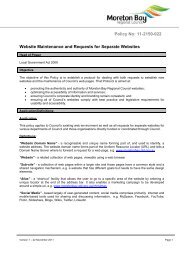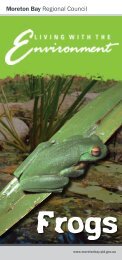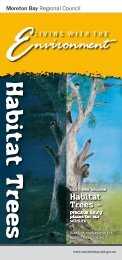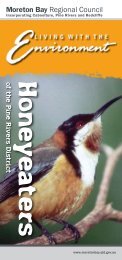South East Queensland Ecological Restoration Framework: Manual
South East Queensland Ecological Restoration Framework: Manual
South East Queensland Ecological Restoration Framework: Manual
Create successful ePaper yourself
Turn your PDF publications into a flip-book with our unique Google optimized e-Paper software.
4<br />
4 Site Assessment<br />
“Detailed site assessments are essential for all successful ecological<br />
restoration projects as this will inform all decisions made throughout the<br />
life of the project, including that of which restoration approach to utilise.”<br />
As part of the site assessment process, it is important that the aims and objectives for the site are clearly<br />
identified prior to commencement as they direct the collection of information and the restoration<br />
activities. The establishment of aims and objectives are described in the Guidelines. Refer to the<br />
Guidelines for additional information on site assessment.<br />
A map of the restoration site, preferably with an aerial photograph background, will be required prior to<br />
assessing the site. The map will be used on site to mark features such as areas of vegetation, native and<br />
weed, access tracks, management issues and proposed work zones.<br />
4.1 Assessment of target site<br />
It is essential to undertake a detailed site assessment, prior to the preparation of an <strong>Ecological</strong><br />
<strong>Restoration</strong> Plan. The following information is intended to assist this process.<br />
Describe the history and background of the site<br />
E.g. was the area previously grazed, when was the area cleared, is it an old house site, was the area ever<br />
used as a dump for industrial waste, was the area logged, what is the fire history? Knowledge of past uses<br />
will help to identify risk factors that are likely to influence the existing native vegetation and the success<br />
of restoration efforts. Understanding site history will help to determine realistic outcomes for the site.<br />
Briefly describe the soils, drainage, topography and aspect<br />
Include any issues that may impact on existing native vegetation or its restoration e.g. re-planting on<br />
an exposed north-facing site may have a detrimental effect on the survival of the plants. The choice<br />
of species for planting may need to be initially restricted to hardy species followed by the inclusion of<br />
more sensitive species at a later date. A soil assessment is necessary to determine the stability of the site<br />
and sensitivity to erosion, and will also influence the selection of plants.<br />
Describe the native vegetation on the site<br />
Describe existing plant community(ies) in terms of broad type and structure e.g. rainforest, tall<br />
sclerophyll forest and, where possible, by its Regional Ecosystem (RE) classification. If minimal native<br />
vegetation remains, describe the pre-existing plant community. (This may be determined by identifying<br />
nearby natural areas and/or by utilising the <strong>Queensland</strong> Herbarium Pre-clearing Regional Ecosystem<br />
mapping as a guide). Identify any threatened species listed under the Nature Conservation Act 1992<br />
or the Commonwealth’s Environment Protection and Biodiversity Conservation Act 1999. Identify the<br />
presence and location of otherwise significant plants such as locally uncommon species, hollow<br />
bearing trees and important feed resources, such as confirmed glossy black-cockatoo feed trees.<br />
Provide a species list and where needed an accurate tree survey.<br />
The following should be considered when assessing existing vegetation communities:<br />
a. Is the structure of the existing native vegetation on the site typical of its forest type? For<br />
instance, does subtropical rainforest remnant on the site have a dense and thick canopy with<br />
trees closely spaced? Does it have native plants in the understorey, a mid-layer, lower canopy<br />
and upper canopy? Is there evidence of regenerating plants and seedlings at ground level?<br />
SEQ <strong>Restoration</strong> <strong>Framework</strong><br />
78<br />
MANUAL


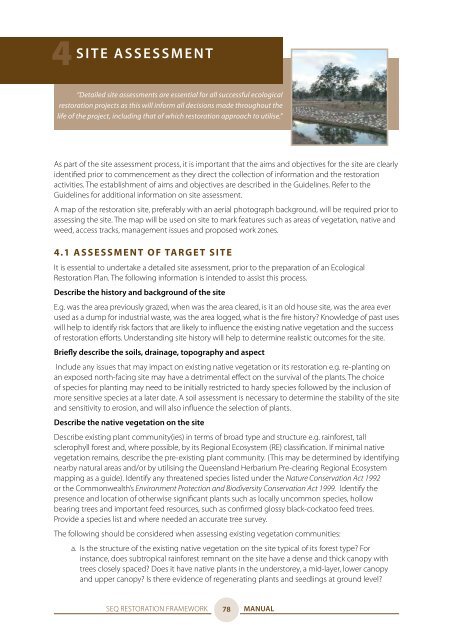
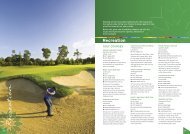
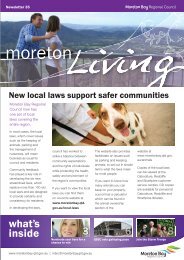
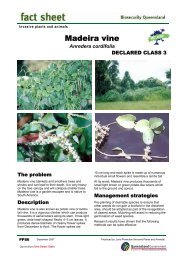
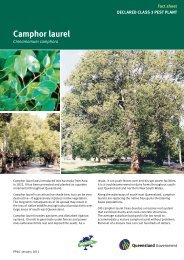


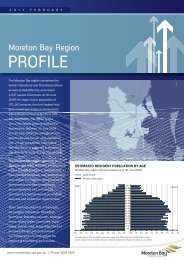
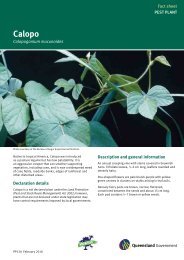

![Kumbartcho Brochure [PDF 540KB] - Moreton Bay Regional Council](https://img.yumpu.com/47220970/1/190x101/kumbartcho-brochure-pdf-540kb-moreton-bay-regional-council.jpg?quality=85)
